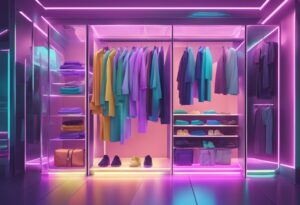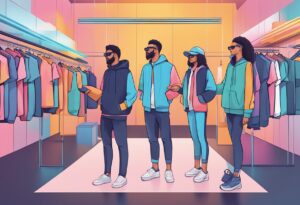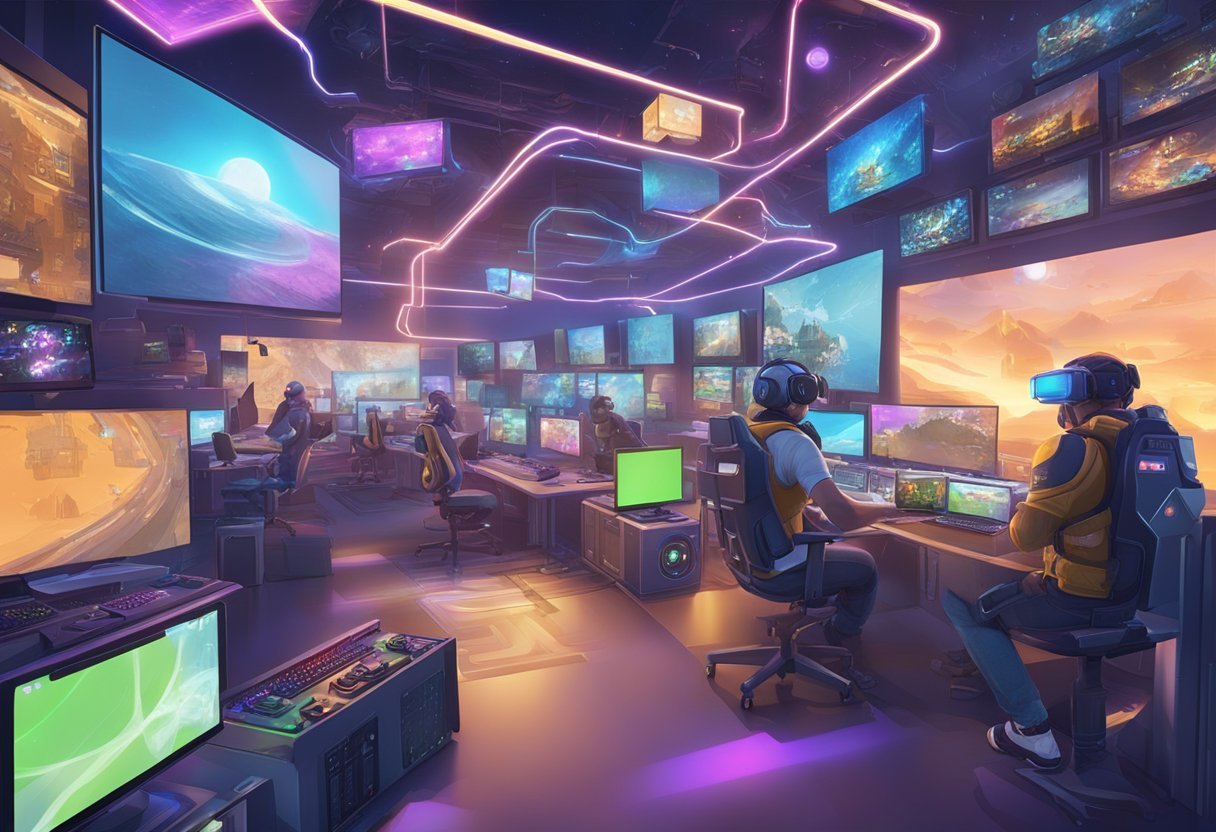The rise of the metaverse has brought about a new concept in the fashion industry – digital clothing. Metaverse clothes are virtual garments that can be worn by avatars in digital spaces, such as virtual reality or online gaming worlds. Digital fashion has become increasingly popular in recent years, with fashion brands and designers creating unique pieces that can only be worn in the virtual world.
One of the benefits of digital fashion is its sustainability. As the fashion industry is one of the largest polluters in the world, creating virtual garments that do not require physical production can significantly reduce its environmental impact. Digital fashion allows for greater creativity and experimentation, as designers are not limited by the physical constraints of fabrics and materials. Virtual garments can be designed in any color, shape, or form, allowing for endless possibilities.
As the metaverse continues to grow, so does the demand for metaverse clothes. With the rise of virtual events and social gatherings, digital fashion has become a way for individuals to express themselves in the virtual world. As more people spend time in virtual spaces, it is likely that digital fashion will become a more significant part of the fashion industry, ultimately changing the way we think about clothing.
The Rise of Digital Fashion in the Metaverse
What are Metaverse Clothes
Metaverse clothes refer to digital clothing that users can wear in virtual spaces, including gaming platforms, 3D virtual worlds, and augmented reality environments. These clothes are designed to enhance the user’s experience in the virtual world and can be customized to suit their preferences.
How Clothes Work in the Metaverse
Users can purchase virtual clothes using cryptocurrency or fiat currency. Once they have made the purchase, they can download the clothes and wear them on their avatars. The clothes can be worn in virtual spaces, and users can take pictures or videos of themselves wearing the clothes.
Evolution of Virtual Clothing
Virtual clothing has been around for a while, but it has gained traction in recent years due to advances in technology. The rise of NFTs has also contributed to the popularity of virtual clothing, as users can now own unique digital designs that can be used to create virtual fashion collections.
Impact of Technology on Fashion
Technology has had a significant impact on the fashion industry, and the rise of virtual fashion is no exception. Virtual fashion allows designers to create digital collections that can be worn by avatars in virtual spaces. This has opened up new opportunities for designers to showcase their creative skills and reach a wider audience.
Virtual fashion has also had an impact on the luxury fashion industry, with luxury brands such as Gucci and Louis Vuitton launching virtual collections. These collections are designed to appeal to a younger audience and showcase the brand’s creativity and innovation.
Major Brands and Designers in Metaverse Fashion

As the metaverse continues to expand, major brands and designers are embracing the potential of digital fashion and exploring new ways to engage with their audiences. This section will highlight some of the luxury brands and collaborations that have made significant strides in the metaverse fashion space.
Luxury Brands Embracing the Metaverse
Several luxury brands have already made their mark in the metaverse fashion space. Louis Vuitton, for example, launched a collection of NFTs in collaboration with Beeple, featuring digital versions of some of the brand’s iconic pieces. Dior has also entered the metaverse, partnering with Genies to create virtual avatars that can wear Dior clothing and accessories.
Gucci, on the other hand, has been particularly active in the metaverse fashion space, selling virtual clothing and accessories on Roblox and creating a virtual Gucci Garden experience in collaboration with Roblox. The brand has also partnered with Aria to create a limited-edition collection of NFTs that sold out in minutes.
Collaborations and Partnerships
Collaborations and partnerships are also becoming increasingly common in the metaverse fashion space. Ralph Lauren, for example, has teamed up with Bitmoji to create a virtual wardrobe that users can dress their avatars in. Nike has partnered with Zepeto to create a virtual store where users can buy digital versions of Nike sneakers.
Balenciaga has also been active in the metaverse fashion space, partnering with Fortnite to create a virtual fashion show that showcased the brand’s Fall 2021 collection. Givenchy, meanwhile, has collaborated with Roblox to create a virtual showroom where users can browse and purchase digital versions of the brand’s clothing and accessories.
Major brands and designers are recognizing the potential of the metaverse as a new frontier for fashion, and are exploring new ways to engage with their audiences in this space. With the continued growth of the metaverse, it will be interesting to see how these brands and collaborations continue to evolve and shape the future of fashion.
The Role of NFTs in Metaverse Wardrobes

Understanding Non-Fungible Tokens
Non-Fungible Tokens (NFTs) are unique digital assets that are indivisible and cannot be exchanged for other tokens or assets. NFTs are created using blockchain technology, which ensures that they are secure, transparent, and tamper-proof. NFTs have become increasingly popular in recent years, especially in the world of art and collectibles. However, they are now being used in the fashion industry to create digital clothing and accessories for the metaverse.
Digital Ownership and NFT Marketplaces
One of the key benefits of NFTs is that they allow for digital ownership of assets. This means that users can buy, sell, and trade digital clothing and accessories just like physical items. NFT marketplaces, such as DressX, provide a platform for fashion brands and designers to sell their digital products to consumers. NFT marketplaces also allow for the creation of limited edition digital fashion items, which can increase their value and appeal to collectors.
NFTs have the potential to revolutionize the fashion industry by providing solutions to some of its biggest challenges. For example, NFTs can help reduce waste by allowing for the creation of digital clothing and accessories that do not require physical production. NFTs can provide a new revenue stream for fashion brands and designers, especially in the era of metaverse fashion and shopping.
NFTs are poised to play a significant role in the future of fashion and the metaverse. As the market for digital fashion and NFTs continues to grow, it will be interesting to see how fashion brands and designers adapt to this new landscape.
Consumer Interaction with Metaverse Apparel
As the metaverse continues to grow and expand, the fashion industry is beginning to explore the possibilities of virtual clothing. Consumers are now able to shop for and customize their virtual wardrobe, creating a unique expression of their identity through their avatar’s fashion choices.
Shopping and Customization Experiences
In the digital fashion world, consumers can browse and purchase virtual clothes in virtual stores. They can also customize their avatar’s appearance with a range of virtual designs, allowing them to express themselves in ways that may not be possible in the physical world.
This provides a new level of self-expression and creativity, allowing consumers to experiment with their fashion choices in a safe and immersive environment.
Expression and Identity through Avatar Fashion
Virtual clothing is not just about shopping and customization; it is also about self-expression and identity. By choosing what their avatar wears, consumers can create a unique representation of themselves in the metaverse. This is particularly important for younger generations who value self-expression and individuality.
Luxury fashion brands are also beginning to explore the potential of virtual clothing, with some even creating fashion NFTs (non-fungible tokens) for their virtual designs. This allows consumers to own unique and rare virtual clothing items, providing a new level of exclusivity and status in the digital fashion world.
The growth of the metaverse is providing new solutions for the fashion industry, allowing for more immersive and creative consumer experiences. As virtual worlds continue to expand, it will be interesting to see how the gaming market, social media, and even the workplace will integrate with the metaverse, further expanding the possibilities for virtual clothing.

Future Trends and Predictions for Metaverse Fashion
Innovative Technologies Shaping the Future
The future of metaverse fashion is being shaped by innovative technologies that are changing the way people interact with digital clothing. One of the most significant of these technologies is non-fungible tokens (NFTs), which are unique digital assets that can be bought and sold like physical goods.
NFTs are already being used in the fashion industry to create virtual clothing collections and to sell unique pieces of digital fashion.
Another technology that is driving the growth of metaverse fashion is virtual and augmented reality. These technologies allow users to experience immersive virtual environments and to try on virtual clothes in real-time. This has significant implications for the fashion industry, as it allows consumers to shop for clothes in a more interactive and engaging way.
Economic and Cultural Implications
Metaverse fashion has significant economic and cultural implications for the fashion industry. As more people start to play, work, and socialize in virtual environments, the demand for virtual clothes and accessories is likely to increase. This presents significant opportunities for fashion brands to create new products and to expand their reach into the digital space.
Metaverse fashion has the potential to change the way people express themselves through clothing. In the metaverse, people can experiment with new styles and looks without the constraints of physical clothing. This has significant implications for the fashion industry, as it allows for more creative expression and experimentation.
The growth of metaverse fashion is being driven by a convergence of digital and physical worlds. As more people start to own their own metaverse and spend time in virtual environments, the demand for virtual clothing and accessories is likely to increase. This presents significant opportunities for fashion brands to create new products and to expand their reach into the digital space.
Frequently Asked Questions
How can I purchase clothing in the metaverse?
Purchasing clothing in the metaverse is similar to purchasing clothing in the physical world. Users can browse through virtual stores and purchase items using digital currency. Some metaverse platforms have their own virtual currency, while others accept popular cryptocurrencies like Bitcoin and Ethereum.
What are some prominent fashion brands operating within the metaverse?
Several prominent fashion brands have started operating within the metaverse, including Gucci, Burberry, and Louis Vuitton. These brands have created virtual versions of their stores and have started selling virtual clothing items. Some new virtual fashion brands have emerged that specialize in creating clothing specifically for the metaverse.
Are there virtual fashion shows, and how can I attend one?
Yes, there are virtual fashion shows in the metaverse. These shows are similar to physical fashion shows, but they take place in virtual spaces and are attended by avatars. Some fashion brands host their own virtual fashion shows, while others participate in larger virtual events that showcase multiple designers. To attend a virtual fashion show, users need to have an avatar and access to the metaverse platform where the show is taking place.
Can users try on clothes virtually before buying in the metaverse?
Yes, users can try on clothes virtually before buying in the metaverse. Some virtual stores have virtual changing rooms where users can try on digital versions of clothing items. Some metaverse platforms have built-in tools that allow users to create their own avatars and try on virtual clothing items.
Who are the leading fashion designers creating metaverse apparel?
Several fashion designers have started creating metaverse apparel, including The Fabricant, Carlings, and Hanifa. These designers create digital clothing items that can be worn by avatars in the metaverse. Some designers also create virtual versions of their physical clothing items.
What are the average prices for virtual clothing in the metaverse?
The prices for virtual clothing items in the metaverse vary widely. Some items are priced similarly to physical clothing items, while others are priced much higher. The prices are determined by factors such as the brand, the design, and the rarity of the item. Some virtual clothing items are also sold as non-fungible tokens (NFTs), which can significantly increase their value.




